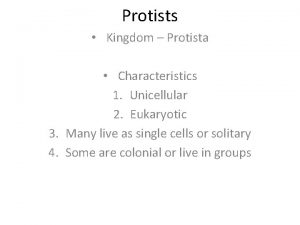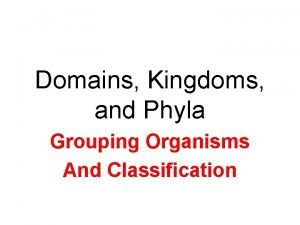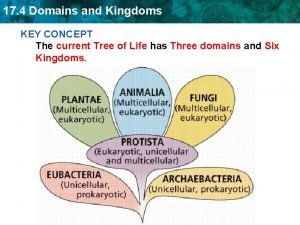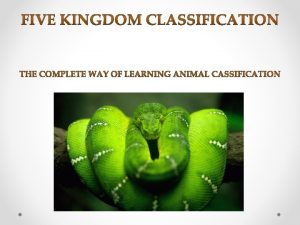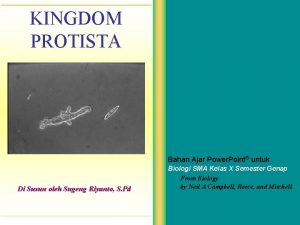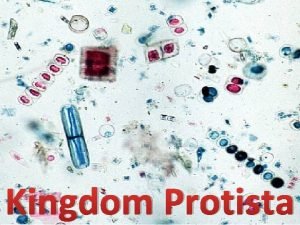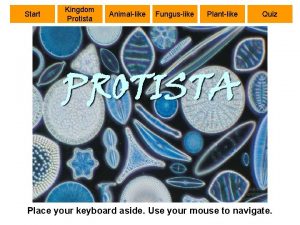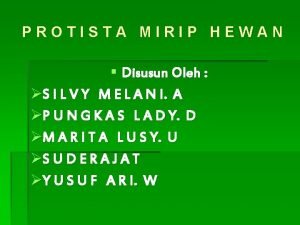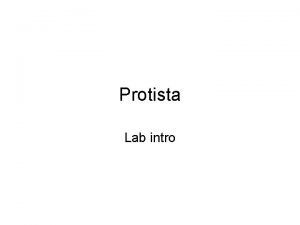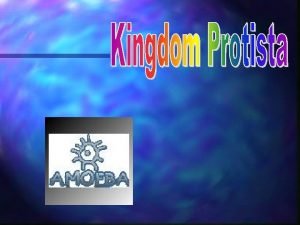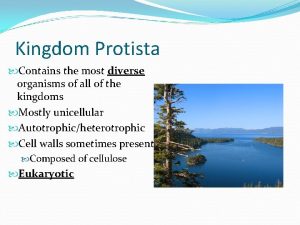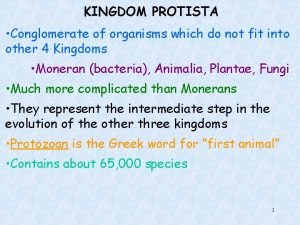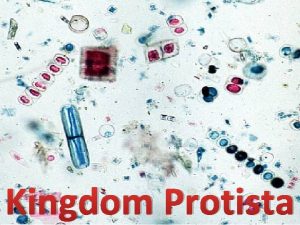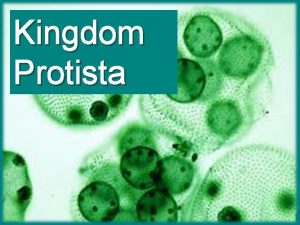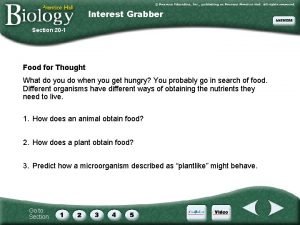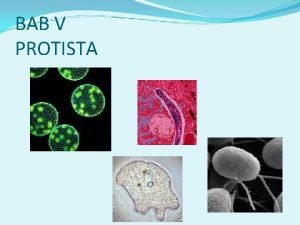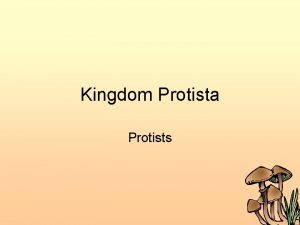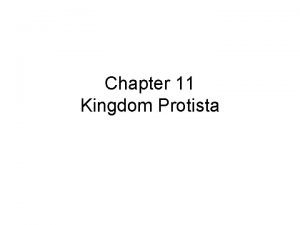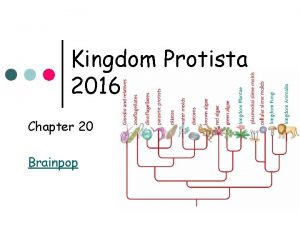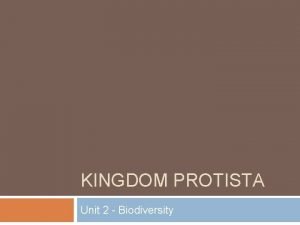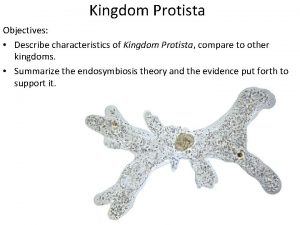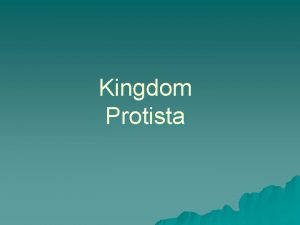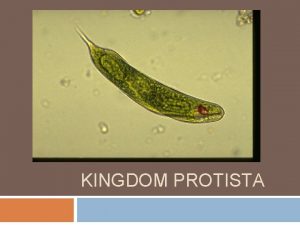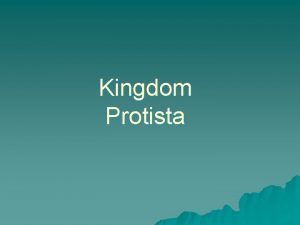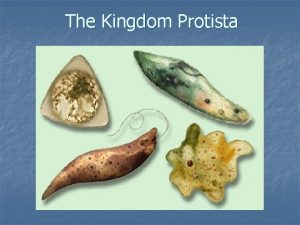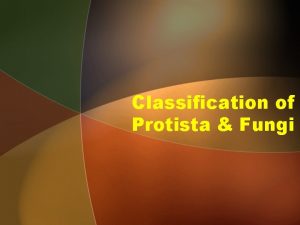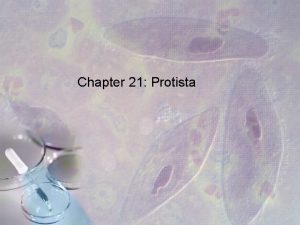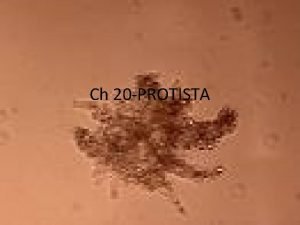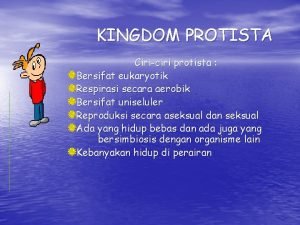Chapter 15 Lecture Outline Kingdom Protista Copyright The














































- Slides: 46

Chapter 15 Lecture Outline Kingdom Protista Copyright © The Mc. Graw-Hill Companies, Inc. Permission required for reproduction or display.

Outline v Introduction v Features of Kingdom Protista v Algae v Phylum Chlorophyta – The Green Algae v Phylum Chromophyta – The Yellow-Green Algae, Golden-Brown Algae, Diatoms, and Brown Algae v Phylum Rhodophyta – The Red Algae v Phylum Euglenophyta – The Euglenoids v Phylum Dinophyta – The Dinoflagellates v Phylum Cryptophyta – The Cryptomonads v Phylum Prymnesiophyta (Haptophyta) – The Haptophytes v Phylum Charophyta – The Stoneworts v Human and Ecological Relevance of the Algae v Phylum Myxomycota – The Plasmodial Slime Molds v Phylum Dictyosteliomycota – The Cellular Slime Molds v Phylum Oomycota – The Water Molds

Introduction v Less than 1 billion years ago, organisms confined to oceans. • Protected from drying out, ultraviolet radiation, and large fluctuations in temperature • Absorbed nutrients directly from water v About 400 million years ago, green algae began making transition from water to land. • Gave rise to green plants – Coleochaete probably indirect ancestor of land plants. o Shares features with land plants: cells that resemble parenchyma, development of cell plate and phragmoplast during mitosis, a protective covering for zygote, and production of lignin-like compound Coleochaete

Features of Kingdom Protista v Domain Eukarya - All members have eukaryotic cells. • Includes Kingdoms: Protista, Plantae, Fungi, Animalia v Organisms in Protista vary from unicellular to multicellular. • Nutrition varied: photosynthetic, ingestion of food, absorption of food • Individual life cycles vary considerably. • Reproduction generally by cell division and sexual processes. v Algae are in Kingdom Protista. • Grouped into several phyla based on form of reproductive cells, and combinations of pigments and food reserves.

Phylum Chlorophyta v Green algae • Unicellular, filamentous, platelike colonies, netlike tubes, hollow spheres, lettuce-like leaves • Greatest variety in freshwater lakes, ponds, and streams – Some on tree bark, in animal fur, in snowbanks, in flatworms or sponges, on rocks, in lichen “partnerships. ” • Have chlorophylls a and b • Store food as starch • Most have a single nucleus per cell. • Most reproduce both sexually and asexually.

Phylum Chlorophyta v Chlamydomonas • Common inhabitant of freshwater pools • Unicellular • Pair of whip-like flagella on one end pull cell through water. • Two or more vacuoles at base of flagella – Regulate water content of cell and remove waste • Single, cup-shaped chloroplast with one or two pyrenoids inside – Pyrenoids - Proteinaceous structures associated with synthesis of starch • Red eyespot near base of flagella – Allows alga to swim toward light

Phylum Chlorophyta v Chlamydomonas • Asexual reproduction: – Nucleus divides by mitosis, and cell contents become two daughter cells within cellulose wall. o Each develop flagella and swim away. o No change in chromosome number; all cells remain haploid.

Phylum Chlorophyta v Chlamydomonas sexual reproduction: • Meiosis occurs in zygospore, producing 4 haploid zoospores that grow into full-sized algae. • Under certain conditions, cells congregate together. • Two cells fuse together to form zygote, that will become zygospore and may remain dormant.

Phylum Chlorophyta v Ulothrix • Filamentous with holdfast cell at one end • Chloroplast - Wide, curved, somewhat flattened, with one to several pyrenoids • Asexual reproduction: – Cells contents condense, divide by mitosis and become zoospores inside parent cell. – Zoospores escape through pore in parent cell wall. o Resemble Chlamydomonas cells o Grow into new filaments

Phylum Chlorophyta v Ulothrix sexual reproduction: • Cell contents condense and divide by mitosis inside parent cell. • Each new cell produces flagella. • Cells escape from parent cell and become gametes.

Phylum Chlorophyta v Spirogyra (watersilk) • Filaments of cylindrical cells • Frequently floats in masses on surface of quiet freshwater • Chloroplast ribbon-shaped and spirally wrapped around vacuole, with pyrenoids at regular intervals. • Asexual reproduction: – Only by fragmentation of filament

Phylum Chlorophyta v Spirogyra (watersilk) • Sexual reproduction by conjugation. – Papillae fuse and form conjugation tubes. – Condensed protoplast of one filament flows or crawls through tube to adjacent cell. – Protoplasts fuse, forming zygote that develops thick wall. – Eventually zygote undergoes meiosis.

Phylum Chlorophyta v Oedogonium • Epiphytic filamentous green alga with holdfast • Large netlike chloroplast with pyrenoids at intersections of net • Asexual reproduction: – By fragmentation or by zoospores – Zoospores produced singly in cells at tips of filaments. o Have about 120 flagella that form fringe toward one end of zoospore

Phylum Chlorophyta v Oedogonium sexual reproduction: • Exhibits oogamy - One gamete is motile, while other is larger and stationary. – – Antheridium - Boxlike cell that produces two motile sperm Oogonium - Swollen cell containing single egg Sperm enters oogonium through pore. • Zygote forms thick walls and may remain dormant. • Zygote produces 4 zoospores by meiosis that grow into new haploid filaments. •

Phylum Chlorophyta v Other green algae • Chlorella - Widespread green alga composed of tiny spherical cells – Only reproduce asexually by forming either daughter cells or autospores through mitosis – Used in research; may become important as food source • Desmids - Mostly free-floating and unicellular – Reproduce by conjugation Closterium, a desmid

Phylum Chlorophyta v Other green algae • Hydrodictyon (water nets) - Net-like, tubular colonies with hexagonal or polygonal meshes – – Asexual reproduction, as well as isogamous sexual reproduction Isogamous = two flagellated gametes

Phylum Chlorophyta v Other green algae • Acetabularia (mermaid’s wineglass) - Consists of a single, huge cell shaped like a delicate mushroom – Used in classic experiments demonstrating influence of nucleus on form of cell – Isogamous

Phylum Chlorophyta v Other green algae • Volvox - Colonial green algae held together in a secretion of gelatinous material, resembling hollow ball – Reproduction asexual or sexual o Smaller daughter colonies formed inside parent colony

Phylum Chlorophyta v Other green algae • Ulva (sea lettuce) - Multicellular seaweed with flattened green blades and basal holdfast to anchor blades to rocks – – Haploid and diploid blades o Diploid blades produce spores that develop into haploid blades. o Haploid blades bear gametangia that form gametes. o Gametes fuse to form zygotes that grow into diploid blades. Exhibit isomorphism - Haploid and diploid blades indistinguishable.

Phylum Chromophyta v Yellow-green algae (Xanthophyceae) • Mostly freshwater, with a few marine and terrestrial representatives – Two flagella of motile cells are oriented in opposite directions. – Vaucheria - Oogamous, coenocytic, filamentous species o Aplanospores formed during asexual reproduction. o Sexual reproduction rare. Stipitococcus, a yellow-green algae Sexual reproduction in Vaucheria

Phylum Chromophyta v Golden-brown algae (Chrysophyceae) • Most occur in the plankton of fresh water. – Motile cells have two flagella of unequal length inserted at right angles to each other. o Photoreceptor on short flagellum.

Phylum Chromophyta v The Diatoms (Bacillariophyceae) • Unicellular • Fresh and salt water, particularly abundant in cold marine habitats • Also, dominate algal flora on damp cliffs, tree bark or buildings • Look like ornate, glass boxes with lids – As much as 95% of wall is silica. • Chlorophylls a and c and fucoxanthin • Food reserves - Oil, fats or laminarin

Phylum Chromophyta v The Diatoms (Bacillariophyceae) • Asexual reproduction results in half of cells becoming progressively smaller. • Original cell size restored through sexual reproduction.

Phylum Chromophyta v Brown algae (Phaeophyceae) • Relatively large; none unicellular or colonial • Most marine; majority in cold, shallow water, except giant kelp • Many have a thallus differentiated into a holdfast, a stipe, and blades. – Blades may have gas-filled bladders. • Chlorophylls a and c, fucoxanthin • Food reserve = laminarin • Algin in cell walls. Nereocystis, a kelp

Phylum Chromophyta v Brown algae (Phaeophyceae) • Sargassum - Floating brown seaweed • Asexual reproduction by fragmentation or autospores. Sargassum

Phylum Chromophyta v Brown algae (Phaeophyceae) • Fucus - Common rockweed – Sexual reproduction: o Receptacles at tips of branches contain spherical chambers called conceptacles with gametangia inside. « Oogonium produces 8 eggs. « Antheridium produces 64 sperm. o Eggs and sperm released into water.

Phylum Rhodophyta v The red algae • In warmer and deeper waters than brown algae • Most are filamentous with filaments so tightly packed they appear to have flattened blades or branched segments.

Phylum Rhodophyta v The red algae • Relatively complex life cycle involving three types of thallus structures • Nonmotile reproductive cells

Phylum Rhodophyta v The red algae • Colors mostly due to phycobilins. – Similar to those of cyanobacteria o Red algae may have been derived from cyanobacteria. • Chlorophylls a, and sometimes d • Food reserve - Floridean starch • Numbers of species produce agar.

Phylum Euglenophyta v The Euglenoids • No cell wall; pellicle = plasma membrane and underlying strips that spiral around cell • Flagellum pulls cell through water. • Gullet ingests food. • About 1/3 of species have disc -shaped chloroplasts. • Red eyespot for light detection • Paramylon food reserve • Asexual reproduction by cell division. • Sexual reproduction not confirmed.

Phylum Dinophyta v The Dinoflagellates • Red tides - Sudden multiplication of dinoflagellates – Some produce neurotoxins that accumulate in shell fish. • Cellulose “armor plates” inside cell membrane • Two flagella in intersecting grooves – One trails behind cell - Acts as rudder – Other encircles cell at right angles - Gives cell spinning motion

Phylum Dinophyta v The Dinoflagellates • Most have disc-shaped chloroplasts. – Contain xanthophyll pigments – Chlorophylls a and c • About 45% nonphotosynthetic • Chromosomes remain condensed and visible throughout life of cell. • Starch food reserve • Many have tiny projectiles that fire when irritated.

Phylum Cryptophyta v The Cryptomonads • Marine and freshwater • Two flagella • Plates on inside of plasma membrane • Single, two-lobed chloroplast with starch granules surrounding a central pyrenoid • Nucleomorph - Vestigial nucleus of primitive symbiotic organism • Gullet lined with ejectosomes. • Sexual reproduction unknown.

Phylum Prymnesiophyta (Haptophyta) v The Haptophytes • Fresh and saltwater; major component of marine plankton • Most unicellular, with two smooth flagella of similar length inserted at the apex. • Pigments and food reserve similar to Chromophyta. • Haptonema - Third flagellum located between two flagella. – Aids in food capture • Often covered in scales • Two disc-shaped chloroplasts

Phylum Charophyta v The Stoneworts • Shallow, freshwater lakes and ponds • Often precipitate calcium salts on their surfaces • Axis with short lateral branches in whorls. • Sexual reproduction is oogamous. • Multicellular antheridia

Human and Ecological Relevance of Algae v Protistan algal phyla at bottom of food chain. v Diatoms • Oils are sources of vitamins. • Diatomaceous earth v – Filtration – Polishes, toothpaste – Paint that reflects light Other algae • Chlorella – Potential human food source

Human and Ecological Relevance of Algae v Algin • Produced by giant kelps and other brown algae – Ice cream, salad dressing – Latex paint, textiles, ceramics – Regulates water behavior o Controls development of ice crystals o Regulates penetration of water o Stabilizes suspensions Vessel harvesting kelp

Human and Ecological Relevance of Algae v Minerals and food • Iodine from kelp • Red algae v – Food - Dulse, nori – Carrageenan - Thickening agent Agar • Produced by red alga Gelidium – Solidifier of nutrient culture media – Retains moistness in bakery products – Base for cosmetics

Phylum Myxomycota v The Plasmodial slime molds • Without chlorophyll – Feed on bacteria and other organic particles • Consist of a plasmodium – Protoplasm containing many diploid nuclei – No cell wall – Flows rapidly and rhythmically – Found on damp forest debris, under logs, on dead organic material Plasmodium

Phylum Myxomycota v The Plasmodial slime molds • Sexual reproduction: – Plasmodium converts into separate small sporangia that contain spores. Sporangia from various plasmodial slime molds

Phylum Myxomycota v The Plasmodial slime molds • Sexual reproduction: – Meiosis occurs in spores. – Spores grow into myxamoebae that act as gametes and fuse to form zygotes. – Zygotes grow into new plasmodia.

Phylum Dictyosteliomycota v The Cellular slime molds • Individual amoebalike cells feed independently, dividing and producing separate new cells periodically. • Clump together to form mass called pseudoplasmodium v – Crawls like a garden slug – Eventually transforms into sporangium-like mass of spores Human and ecological relevance of the slime molds: – Break down organic particles to simpler substances

Phylum Oomycota v The Water molds • Cottony growths on fish; often found on dead insects • Range in form from single spherical cells to branching, threadlike, coenocytic hyphae – Coenocytic hyphae are not divided into individual cells and may form large thread masses (mycelia). • Share features with brown algae, including oogamy, cellulose in cell walls, predominantly diploid lifecycle, and zoospores with two flagella • Asexual reproduction: – Crosswalls form at tips of hyphae – Zoospores produced inside and emerge through pore.

Phylum Oomycota v The Water molds • Sexual reproduction: – Meiosis takes place in oogonia and antheridia. – Zygotes formed in oogonia give rise to new mycelia. • Human and ecological significance of the water molds: – Downy mildew on grapes – Potato blight o 1846 famine in Ireland

Outline v Introduction v Features of Kingdom Protista v Algae v Phylum Chlorophyta – The Green Algae v Phylum Chromophyta – The Yellow-Green Algae, Golden-Brown Algae, Diatoms, and Brown Algae v Phylum Rhodophyta – The Red Algae v Phylum Euglenophyta – The Euglenoids v Phylum Dinophyta – The Dinoflagellates v Phylum Cryptophyta – The Cryptomonads v Phylum Prymnesiophyta (Haptophyta) – The Haptophytes v Phylum Charophyta – The Stoneworts v Human and Ecological Relevance of the Algae v Phylum Myxomycota – The Plasmodial Slime Molds v Phylum Dictyosteliomycota – The Cellular Slime Molds v Phylum Oomycota – The Water Molds

 Old kingdom middle kingdom new kingdom
Old kingdom middle kingdom new kingdom Nnn ruled
Nnn ruled Youtube egypt
Youtube egypt Old kingdom middle kingdom new kingdom
Old kingdom middle kingdom new kingdom Protista characteristics
Protista characteristics Giant kelp phylum
Giant kelp phylum Protista kingdom
Protista kingdom Unicellular fungi examples
Unicellular fungi examples Kingdom protista concept map
Kingdom protista concept map Protista
Protista Kingdom monera protista fungi plantae animalia
Kingdom monera protista fungi plantae animalia Ppt protista kelas 10
Ppt protista kelas 10 Fungi eukarya
Fungi eukarya Protista examples
Protista examples Protist evolution
Protist evolution Introduction to the protists
Introduction to the protists Kingdom protista multicellular unicellular
Kingdom protista multicellular unicellular Kingdom protista habitat
Kingdom protista habitat Is animalia prokaryotic or eukaryotic
Is animalia prokaryotic or eukaryotic Protophyta characteristics
Protophyta characteristics Importance of kingdom protista
Importance of kingdom protista Most diverse kingdom
Most diverse kingdom Characteristics of protoctista
Characteristics of protoctista Kingdom protista
Kingdom protista Protista plantae
Protista plantae Kingdom protista characteristics
Kingdom protista characteristics Distinguishing features of kingdom protista
Distinguishing features of kingdom protista Section 20-1 the kingdom protista
Section 20-1 the kingdom protista Ciri ciri protista mirip hewan
Ciri ciri protista mirip hewan 01:640:244 lecture notes - lecture 15: plat, idah, farad
01:640:244 lecture notes - lecture 15: plat, idah, farad Lecture outline example
Lecture outline example Lecture outline example
Lecture outline example Lecture outline example
Lecture outline example Lecture outline meaning
Lecture outline meaning Similarities between protists and fungi
Similarities between protists and fungi What do kingdom fungi and kingdom plantae share
What do kingdom fungi and kingdom plantae share What kingdom is considered the ods and ends kingdom?
What kingdom is considered the ods and ends kingdom? How to write a quote sandwich
How to write a quote sandwich Hình ảnh bộ gõ cơ thể búng tay
Hình ảnh bộ gõ cơ thể búng tay Frameset trong html5
Frameset trong html5 Bổ thể
Bổ thể Tỉ lệ cơ thể trẻ em
Tỉ lệ cơ thể trẻ em Gấu đi như thế nào
Gấu đi như thế nào Tư thế worms-breton
Tư thế worms-breton Alleluia hat len nguoi oi
Alleluia hat len nguoi oi Các môn thể thao bắt đầu bằng tiếng bóng
Các môn thể thao bắt đầu bằng tiếng bóng Thế nào là hệ số cao nhất
Thế nào là hệ số cao nhất




